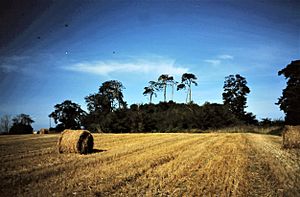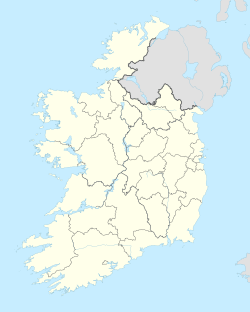Castlemore Moat facts for kids
|
Ráth an Chaisleáin Mhóir
|
|
 |
|
| Alternative name | Castlemore Castle, Fotheret O'Nolan, Rathsillan |
|---|---|
| Location | Castlemore, Fennagh, County Carlow, Ireland |
| Coordinates | 52°48′34″N 6°46′21″W / 52.809489°N 6.772553°W |
| Type | motte |
| Circumference | 50 metres (55 yd) |
| Height | 9 metres (30 ft) |
| History | |
| Builder | Raymond FitzGerald |
| Material | earth |
| Founded | 12th century |
| Periods | Norman Ireland |
| Cultures | Cambro-Norman, Old English |
| Designation | National Monument |
Castlemore Moat is an ancient castle site in County Carlow, Ireland. It is a special type of castle called a motte-and-bailey. Today, it is protected as a National Monument. This means it is an important historical place that helps us learn about the past.
Contents
Where is Castlemore Moat?
Castlemore Moat is located in County Carlow, Ireland. It is about 2 kilometers (1.2 miles) northwest of the town of Tullow. The site is also about 2 kilometers west of the River Slaney. Be careful not to confuse it with Castlemore House, which is a different building from the 1800s located nearby.
History of Castlemore Moat
Building the Castle
The Castlemore Moat was built in the 1100s. It was created by a famous Norman leader named Raymond FitzGerald. He was also known as Raymond le Gros. He was one of the commanders who helped the Normans invade Ireland.
Raymond FitzGerald was given the land of Forth O'Nolan. He married Basilia, who was the sister of a powerful Norman lord named Strongbow. Raymond and Basilia lived together at Castlemore.
What is a Motte-and-Bailey?
A motte-and-bailey was an early type of castle. It was popular after the Normans invaded England and Ireland.
- The motte was a large, artificial hill. It was usually made of earth. A wooden tower or keep would sit on top of the motte. This high position made it easy to defend.
- The bailey was a fenced-in area next to the motte. It was a courtyard where soldiers, horses, and supplies were kept. The bailey was protected by a ditch and a wooden fence.
These castles were quick to build. They were very important for the Normans to control new lands.
What Remains Today?
Today, only the motte remains at Castlemore. It is an artificial hill about 9 meters (30 feet) high. The motte is not perfectly round. It measures about 18 meters (59 feet) from east to west. It is about 13 meters (43 feet) from north to south.
There is also a standing stone at the site. This stone is about 170 centimeters (5.6 feet) tall. It is 45 centimeters (1.5 feet) wide and 30 centimeters (1 foot) thick. A Latin cross is carved into the stone. The cross has a small foot-rest shape at its base.


